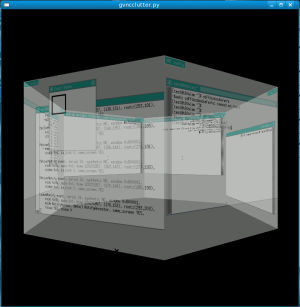VNC sessions on a 3-d spinning cube
In his recent blog posting on redirected direct renderering, Kristian happened to mention Clutter, a toolkit which allows you to do 3d graphics without first needing to acquire a PhD in OpenGL. I made a mental note to give it a try sometime.
On saturday I spent a few hours doing the major upgrade from Fedora 6 to Fedora 8 on my laptop & desktop (skipping F7). I did it the crazy way, just changing my YUM config files & letting it upgrade everything. I can’t say it was a painless process, but I do finally have two working boxes on F8 now. I also took the opportunity to switch my IBM T60p laptop over to the Avivo driver, instead of the VESA driver & which worked without a hitch.
Back on topic. After the upgrade to F8, I poked at the repos and found that (nearly) all the Clutter related bits are packaged & available to Fedora users already. There is just an annoying buildrequires missing in the python bindings spec file, which meant the RPM is missing the GTK & GST APIs for clutter. A quick rebuild fixed that issue. You may remember I’ve been working on a GTK widget for displayed VNC sessions. One evil thought, led to another even more evil thought, and thus I ended up writing a VNC viewer program which displays multiple VNC sessions on a spinning cube. To make it even more evil, I decided to not restrict it to a cube, and instead generalized to an arbitrary number of sides.
The results are spectacular, though a static screenshot doesn’t really do it justice…

Ctrl+Alt+PageUp/PageDown lets you rotate to the previous/next session respectively. The mouse & keyboard events are fully plumbed in so you can actually interact with each session. In this example I just started 6 VNC server instances running TWM at 500×500 pixels, but they could have been real GNOME desktops too. The only issue is that I’ve not yet figured out how todo correct depth sorting of each desktops. You don’t notice this problem in the screenshot, since I’ve just got them all rendering at 50% opacity ;-) It is impressively slow & impressively fast at the same time. Slow because I’m using Avivo which doesn’t have any real 3d rendering support yet; fast because I’m amazed it is actually working at all :-)
Now to hook this all up into the next version of virt-manager….. just kidding ;-P
Very cool :)